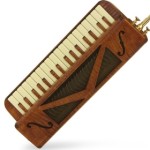vibrato (actually tremolo)
Tagged: vibrato
- This topic has 8 replies, 4 voices, and was last updated 8 years ago by
Gayle H.
-
AuthorPosts
-
December 17, 2013 at 8:28 pm #1188
 KevinParticipant
KevinParticipantI wanted to start a thread on vibrato. I’ve heard some players derive a very emotive vibrato(actually tremolo because you aren’t altering the pitch).
I once read a review where someone thought the spit-valve button was for vibrato. Point of fact pressing it up and down rapidly is a sure way to create a fluttering if somewhat mechanical note.
I usually try and create a throat vibrato as if singing.How do most of you go about it?December 17, 2013 at 9:17 pm #1190 QuetscherParticipant
QuetscherParticipantAs far as I experienced there are three ways to create a vibrato. First is to change mechanically between blowing harder and softer which works quite good for a slow and intense vibrato. If you play around a while with increasing and reducing tempo, you may find out that there is a certain tempo where it feels like you don’t have to do anything to keep up a vibrato. That’s because your diaphragm takes over and beginns to move up and down automatically. (That’s the vibrato most singers use as it is a vibrato that doesn’t influence your larynx, so the vocal cords can swing freely.) It’s also called the natural vibrato because you don’t have to do anything to “produce” it; so you don’t have to move your belly in and out, it works by itself! Only thing is, you can’t influence the tempo of that vibrato, it just remains constant. And the third way is what you described, to use your throat, which is especcially useful for very quick vibratos. The faster you go and the more you actually close your throat, the more it sounds goat-like, which might be useful to imitate a swing clarinet. (But it’s not the real thing because that would require a tremolo – I tried to produce a tremolo by bending fast but it’s nearly impossible!)
With these three ways you should be able to produce a vibrato just as fast and intense as you want.July 5, 2015 at 2:45 am #5560 TomParticipant
TomParticipantWhile working on vibrato I came across this saxophone vibrato instructional video which advocates using the jaw to produce vibrato. Before finding it I noticed this was the type of vibrato I was naturally attempting but am far from mastering. So I’m curious to hear what experienced melodica players feel about this type of vibrato.
July 5, 2015 at 2:46 am #5561 TomParticipantJuly 6, 2015 at 8:28 am #5574
TomParticipantJuly 6, 2015 at 8:28 am #5574 QuetscherParticipant
QuetscherParticipantHi Tom,
I was quite curious if the jaw Vibrato would work for the melodica as well and I just tried a little. I have to say that I didn’t get on with it too well…
Just a little guess why this may be: when I open and close my jaw while playing saxophone, I press the reed against the mouthpiece and then release it which leads to a change of the air channel between reed and mouthpiece which leads to a Vibrato.
When I do the same on my melodica it doesn’t influence the air channel, so no Vibrato. The only thing that I recognized was that the movement of my jaw leaded to a better movement of my diaphragm which may be a good help if the diaphragm Vibrato doesn’t work properly…
July 9, 2015 at 2:01 am #5594 TomParticipant
TomParticipantHi Quetscher,
Thanks for your comments and analysis of the jaw vibrato. What you said about moving the jaw affecting the diaphragm makes sense. Another reason I am curious about this type of vibrato is I saw Mario Duenas playing the saxophone on YouTube and was wondering if jaw vibrato was the type he used on his wonderful melodica version of My Funny Valentine. Can I ask what type of vibrato you use, especially on your moving rendition of Summertime posted on the site? Also in your earlier post above about the three types of vibrato I see a vibrato produced by the diaphragm and one by the throat but somehow I’m not catching the third type. Maybe it is using the spit vavle?
Tom
July 9, 2015 at 7:01 pm #5597 QuetscherParticipant
QuetscherParticipantHi Tom,
I just listened to that great recording of Mario Dueñas. To me it seems to be a diaphragm vibrato, it’s very steady, not too fast and not too slow, that’s what I use on “Summertime” (BTW thanks for your comment on that…).
The third type of vibrato that I mean is a vibrato that you produce by pushing in and releasing your stomach mechanically in the speed you want to. I guess you can practice this similarly to the jaw vibrato.
July 10, 2015 at 1:26 am #5602 TomParticipant
TomParticipantThanks, Quetscher. Looks like I better stop messing around and work on that diaphragm vibrato which sounds so great. I appreciate your insights.
TomApril 14, 2016 at 8:22 pm #7071Gayle H
ParticipantIf you can produce a vibrato while singing, you can produce it the same way on a wind instrument. I am a singer and flautist and produce vibrato on the flute (and melodica) the same way as singing. Indeed, I feel like playing a wind instrument is just an extension of singing. But not all flautists are able to do that and there are various mechanical ways for them to produce vibrato. But if you can do it, a singing (diaphragm) vibrato creates the most beautiful tone.
PS There is spam on this thread (and elsewhere in this forum) and to make matters worse, a new post (I just noticed) by default inherits the spammer’s tags. Is there a way to flag spam and bring it to moderators’ attention?
-
AuthorPosts
- You must be logged in to reply to this topic.
